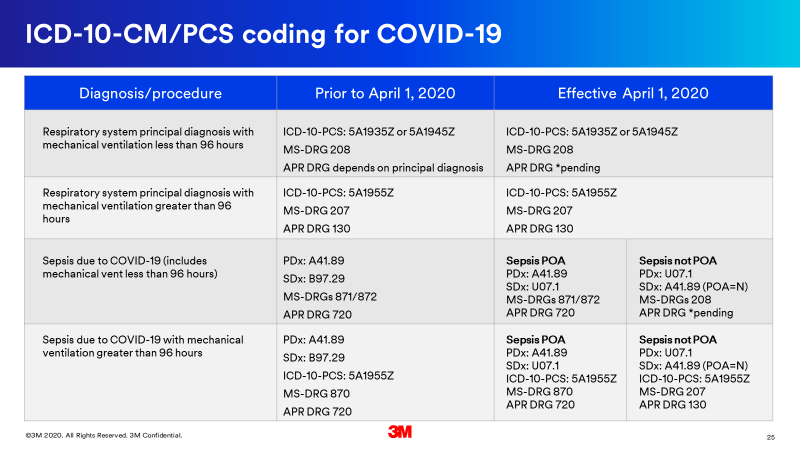Inside Angle
From 3M Health Information Systems
COVID-19 and sepsis coding: New guidelines
During a pandemic, healthcare information is gathered, studied, and published rapidly by scientists, epidemiologists and public health experts without the usual processes of review. Our understanding is rapidly evolving and what we understand today will change over time. Definitive studies will be published long after the fact. 3M Inside Angle bloggers share thoughts and expertise based on currently available information.
On March 31, 2020, the National Center for Health Statistics (NCHS) posted the ICD-10-CM Official Coding Guidelines for COVID-19 – April 1, 2020 through September 30, 2020. In this document, there is a guideline on the sequencing of codes related to COVID-19 (1.g.1b) which states:
b) Sequencing of codes
When COVID-19 meets the definition of principal diagnosis, code U07.1, COVID-19, should be sequenced first, followed by the appropriate codes for associated manifestations, except in the case of obstetrics patients as indicated in Section I.C.15.s. for COVID-19 in pregnancy, childbirth, and the puerperium.
For a COVID-19 infection that progresses to sepsis, see Section I.C.1.d. Sepsis, Severe Sepsis, and Septic Shock
See Section I.C.15.s. for COVID-19 in pregnancy, childbirth, and the puerperium
This official guideline updates all previous advice and information that was published or stated on COVID-19 and sepsis.
The guideline tells us that when COVID-19 and sepsis are documented in the record, refer to the sepsis coding guidelines that are printed in the ICD-10-CM Official Guidelines for Coding and Reporting, FY2020, pp. 24-27. The sequencing of COVID-19 and sepsis will depend on the circumstances of admission. Here are a few examples of sequencing and coding of sepsis and COVID-19:
- COVID-19 and sepsis both documented and present on admission: A41.89 (POA=Y) + U07.1 (POA=Y)
- COVID-19 present on admission and sepsis develops after admission: U07.1 (POA=Y) + A41.89 (PNA=N)
- If the documentation is not clear whether the sepsis was present on admission, the provider should be queried for clarification
Based on these new coding guidelines, the slide from my presentation during the “3M Special Webinar Series – COVID-19: Implications for HIM and CDI” has been updated as follows:
We are learning that everything about COVID-19 is fluid and fast-changing—even in the coding arena. Stay tuned for more updates as they are announced.
Audrey Howard, RHIA, is a senior outsource services consultant with 3M Health Information Systems.
References:
Centers for Disease Control and Prevention, National Center for Health Statistics
ICD-10-CM Official Guidelines for Coding and Reporting, FY 2020



